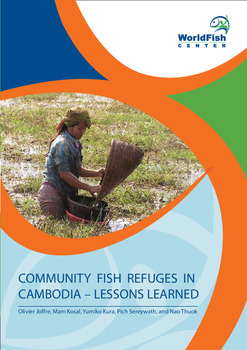Community fish refuges in Cambodia: Lesson learned

Citation
Joffre, O. et al. (2012). Community fish refuges in Cambodia: Lesson learned. Lessons Learned Brief 2012-03. The WorldFish Center. Phom Penh, Cambodia. 16 p.
Cambodia's wetlands cover over 30 percent of the country’s land area and support one of the largest, most diverse and intensive freshwater fisheries in the world. In the flood season (July-February), the flood waters from the Mekong River and Tonle Sap Lake catchments create a vast open water system on Cambodia’s lowlands. During this period, inundated rice fields become open access fishing grounds for local villagers and migrant fishers. Fishing in rice fields and floodplain systems takes place throughout the flood season, but the peak season is when water is receding (from November to February). Rice field fisheries are estimated to contribute up to 28% of the wild capture fisheries in Cambodia. Rice field fisheries are seen as a promising sub-sector to increase fish catches and meet the domestic demand for food. Despite its importance in Cambodia’s rural livelihoods, this complex system of rice field fisheries has not been a focus of detailed research or NGO projects until recently, with the advent of the Community Fish Refuge (CFR) approach. A Community Fish Refuge (CFR) is a form of stock enhancement or a fish conservation measure that is intended to improve the productivity of rice field fisheries. The idea behind refuge ponds is to create dry season refuges or sanctuaries for brood fish in seasonally inundated rice fields. Refuge ponds can be man-made ponds or natural ponds that can hold water throughout the year. During the dry season, these refuge ponds become disconnected from permanent natural water bodies.
Permalink
Date Available
Type
Countries
Copyright
CC BY 4.0
Topics
Language